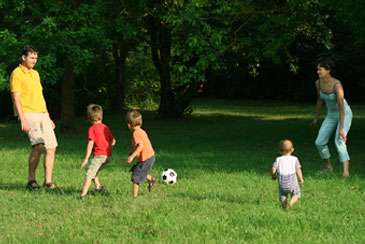Landscaping with a Green Thumb: The Organic Lawn

In this article, you will find:
Keeping the grass green
Keep the Grass HealthyEvery few years, you should overseed your lawn to get new, healthy plants started. Grass that is dense has few weeds and serves as habitat for ants, spiders, and ground beetles, which keep lawn pests in check. In most parts of the U.S., the best time of year to overseed is September. Mow the existing grass short before overseeding (this is one time when you should break the three-inch rule), and be sure to rake the lawn well after overseeding to help the seeds reach the soil below. Choose a grass seed mixture that's right for your climate and conditions—note that there are special mixtures for lawns used as play areas. You might also consider overseeding with clover; it fixes nitrogen, which keeps the lawn green. To help the soil hold water, you can spread a thin layer of screened compost over the lawn once or twice a year. The compost will also lightly fertilize the lawn and help to balance the pH.
Grass does best with about one inch of water every 10 to 14 days, but the Earth-friendly gardener tries to avoid watering it except during the hottest days of summer. You will know that your lawn is thirsty if you leave footprints when you walk on it. When your lawn needs water and no rain is forecast, run the sprinkler—but no more than once a week—and let it run until one inch of water has fallen. (Use a rain gauge to help you determine when the sprinkler has run long enough.) Deep watering like this will cause the grass roots to extend farther into the soil, making the plants healthier and better equipped to withstand drought.
The best time to water is early in the morning. Don't water during the hottest part of the day, because you will lose much of the water to evaporation. And don't water too late in the day, because the overnight dampness can lead to mold and fungus problems.
With drought becoming a regular occurrence in many parts of the country, local authorities must sometimes enforce watering bans. If you are asked to stop watering your lawn, the grass will probably turn brown. It may look awful, but it's not dead. And look on the bright side: You won't have to mow it until it starts raining again!
Related articles:
The Ornamental Garden
The Vegetable Garden
Composting

